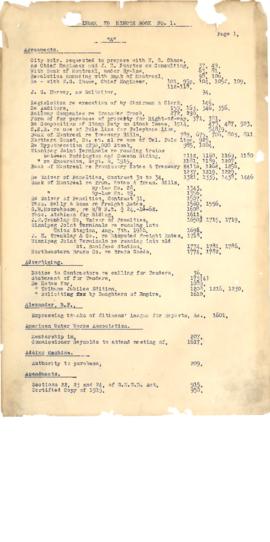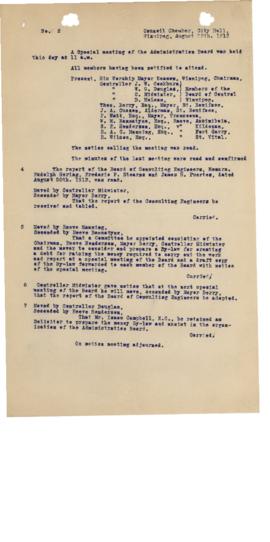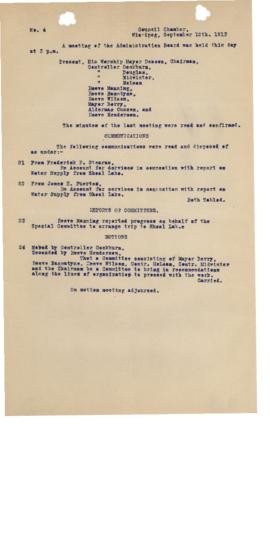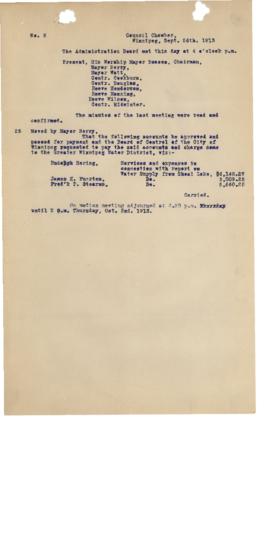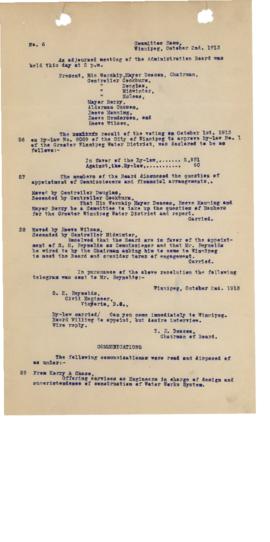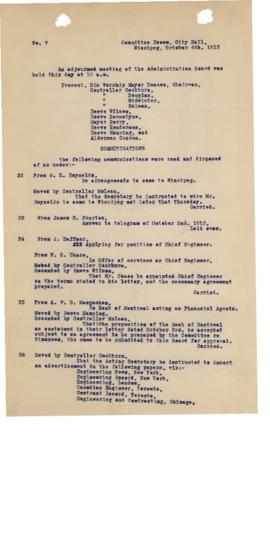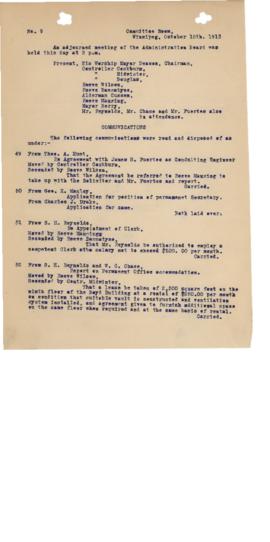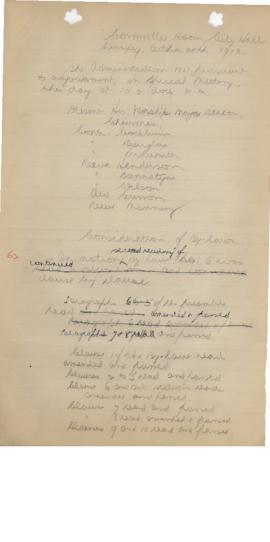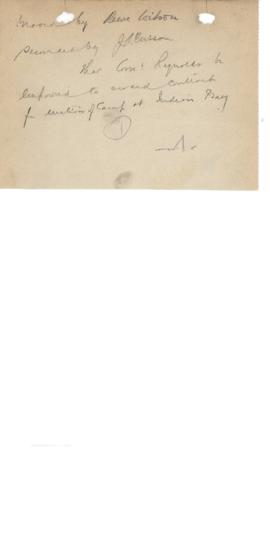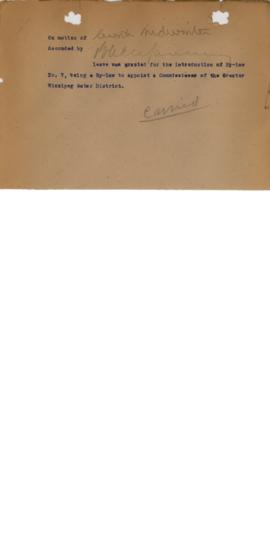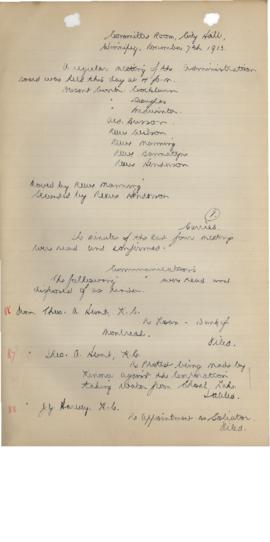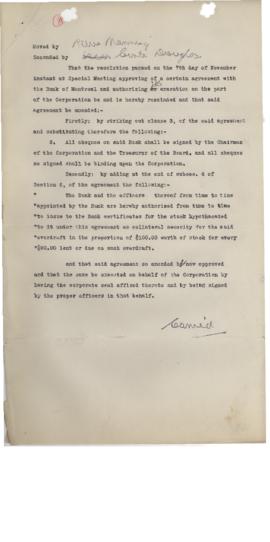Zone du titre et de la mention de responsabilité
Titre propre
GWWD Board of Administration Minutes, 1913-1916
Dénomination générale des documents
- Document textuel
Titre parallèle
Compléments du titre
Mentions de responsabilité du titre
Notes du titre
Niveau de description
Dossier
Cote
Zone de l'édition
Mention d'édition
Mentions de responsabilité relatives à l'édition
Zone des précisions relatives à la catégorie de documents
Mention d'échelle (cartographique)
Mention de projection (cartographique)
Mention des coordonnées (cartographiques)
Mention d'échelle (architecturale)
Juridiction responsable et dénomination (philatélique)
Zone des dates de production
Date(s)
Zone de description matérielle
Description matérielle
12.5 cm of textual records
Zone de la collection
Titre propre de la collection
Titres parallèles de la collection
Compléments du titre de la collection
Mention de responsabilité relative à la collection
Numérotation à l'intérieur de la collection
Note sur la collection
Zone de la description archivistique
Nom du producteur
Histoire administrative
The Greater Winnipeg Water District (GWWD) was incorporated in 1913 to supply water to the City of Winnipeg and surrounding municipalities. In May 1914, construction began on the aqueduct to bring water from Shoal Lake to Winnipeg. In March 1919, water from Shoal Lake flowed into Winnipeg’s taps and on September 9, 1919, His Royal Highness The Prince of Wales (The Prince Edward) dedicated the aqueduct. In 1935, the Greater Winnipeg Sanitary District (GWSD) was incorporated to manage wastewater collection and treatment for the participating sections of the GWWD. These two corporations existed until 1961, when their functions were taken over by the Metropolitan Corporation of Greater Winnipeg.
The GWWD was originally comprised of the City of Winnipeg, the City of St. Boniface, the Town of Transcona, the Rural Municipality of St. Vital, and parts of Fort Garry, Assiniboia, and Kildonan. By 1960, the area serviced by the GWWD also included parts of St. James and Tuxedo.
The GWWD had two boards: the Administration Board and the Board of Commissioners. The Administration Board had the policy-making function and was originally composed of the Mayor and four Councillors of the City of Winnipeg, the Mayor and one Councillor of the City of St. Boniface, the Mayor of Transcona, and the Reeves of the four other municipalities. The Administration Board’s Chairman was the Mayor of Winnipeg. The Board of Commissioners was responsible for operations and it had up to three members. Usually, the Board of Commissioners was composed of a Chairman, Treasurer and one other Commissioner. The Chairman was the City Engineer, and the Treasurer was the Commissioner of Finance of the City of Winnipeg. The third Commissioner was appointed by the Administration Board. A Board of Equalization, appointed by the Public Utilities Commissioner, was also established to determine the assessment levied on the taxable land in each municipality.
The aqueduct was largely built by three contractors, although the GWWD tendered and administered ninety-nine contracts during construction. The three main contractors were J.H. Tremblay Co. Ltd., Thos. Kelly & Sons, and the Winnipeg Aqueduct Construction Co. Ltd.
As no roads existed along the proposed route of the aqueduct, the GWWD created and operated the Greater Winnipeg Water District Railway to run parallel to the route to facilitate the movement of materials and workers. Construction of the railway track began in 1914 and was completed in 1915. The track runs from its terminus in St. Boniface to Waugh, Manitoba near Shoal Lake. After the aqueduct was completed, the railway was also used to carry freight and passengers in an effort to reduce the costs of construction. Freight included firewood, pulpwood, poles, railway ties, ice, mail, milk, gravel and sand. Although initially only three trains ran a week, at the peak of its operation up to four trains a day hauled gravel for use as an aggregate in concrete manufacture.
The first meeting of the GWWD Administration Board took place on July 30, 1913. By the fall of 1913, active work was underway and survey parties were determining the most economical route from Shoal Lake. As the waters of Shoal Lake are part of the Lake of the Woods, which crosses the boundary into the United States, it was necessary to secure the approval of the International Joint Commission. It was also necessary to secure the consent of the Ontario Government as the boundary line between the provinces of Manitoba and Ontario passes through Indian Bay, a tributary of Shoal Lake. Further sections of the aqueduct were located on reserve land belonging to Kekekoziibii Shoal Lake 40 First Nation and the sale of this land was required. The provisions of the Indian Act allowed for reserve lands to be sold with the price of the land set by the Governor in Council and the proceeds of the sale going to the Band. The Department of Indian Affairs valued three thousand acres of Kekekoziibii Shoal Lake 40 First Nation's reserve land at fifty cents per acre. Approximately fifty-five acres on the mainland were valued at three dollars an acre. As the Falcon River ran into the proposed intake area in Indian Bay, a diversion was built so that the waters of Falcon River, which had an unwanted colour, ran into Snowshoe Bay instead. The Falcon River diversion, consisting of a 2.4 km dyke and 840 m channel, solved the problem of unwanted colouration of the water supply, but had the effect of limiting Kekekoziibii Shoal Lake 40 First Nation's access to the mainland.
The City of Winnipeg Archives acknowledges the following sources:
City of Winnipeg, compiled by the City Clerk. Municipal Manual 1955. Winnipeg: Henderson Directories, [1955].
City of Winnipeg, Water and Waste Department, “The Greater Winnipeg Water District Railway.” Last updated June 29, 2018. Available: https://www.winnipeg.ca/waterandwaste/dept/railway.stm
Ennis, David A. “Developing a Domestic Water Supply for Winnipeg from Shoal Lake and Lake of the Woods: The Greater Winnipeg Water District Aqueduct.” Master’s thesis. University of Manitoba, 2011.
Special thanks to the Water and Waste Department for supplying key details.
Historique de la conservation
Digitized by the Water and Waste Department in 2010. Digital and analogue copies sent to City of Winnipeg Archives from Water and Waste Department in 2015 (2015/07).
Portée et contenu
Minutes of the Board of Administration of the Greater Winnipeg Water District from 1913-1916. Minutes record administrative decisions made, votes taken, and motions presented. The minutes are arranged by meeting date, but some minutes are accompanied by related correspondences from earlier or later dates, as well as documents recording specific motions, cards that record how members of the board voted, and shorthand notes. Some minutes are typed while others are handwritten. The minutes were originally bound, but have been removed from their binding and placed into folders. An index is included at the beginning, with subjects arranged alphabetically pointing to numbers that correspond to numbers in the left margin of the minutes. The index was designed to be used for the entirety of the minute book and therefore does not specify which individual meeting the numbers refer to.
Zone des notes
État de conservation
Minutes are somewhat fragile and are fraying at the edges. They have been removed from their original binding and placed in archival folders.
Source immédiate d'acquisition
Classement
Minutes have been removed from their original bindings and placed in five folders ordered mostly (but not entirely) by date. The digital copies have been separated by meeting.
Langue des documents
Écriture des documents
Localisation des originaux
Disponibilité d'autres formats
Restrictions d'accès
There are no restrictions on access to these records.
Délais d'utilisation, de reproduction et de publication
Researchers are responsible for observing Canadian copyright regulations.


